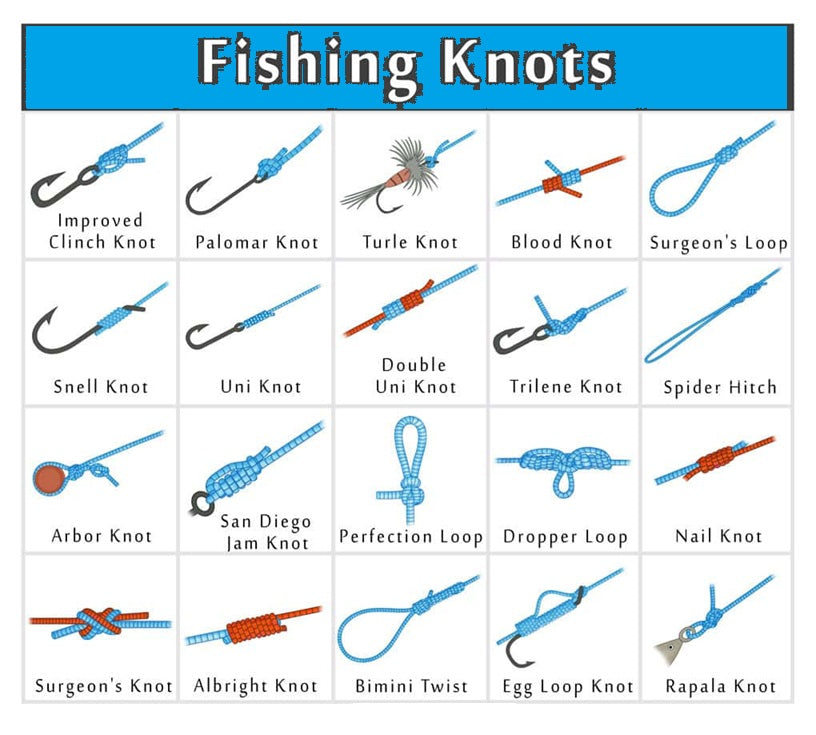
Master Fishing Knots – Essential Techniques for Every Angler
Master Fishing Knots – Essential Techniques for Every Angler
Introduction: Why Fishing Knots Matter More Than You Think
A well-tied fishing knot is the unsung hero of every successful fishing trip. Whether you're battling a trophy bass, finesse fishing for trout, or casting for saltwater giants, your ability to tie strong, reliable knots can determine whether you land a fish or lose it.
Beyond securing hooks and lures, proper knot tying ensures:
• Stronger connections between the mainline, leader, and terminal tackle
• Less risk of breakage under pressure
• Better bait presentation for improved attraction
• More time fishing, less time fixing gear
In this guide, we’ll break down the most essential fishing knots, their best uses, and step-by-step instructions for tying them like a pro.
Top Fishing Knots Every Angler Should Master
1. Improved Clinch Knot – The Classic Hook Knot
• Best for: Securing hooks, lures, and swivels
• Strength Rating: 90%+ in monofilament and fluorocarbon lines
• Why it’s great: Easy to tie, reliable, and widely used by anglers

How to Tie It:
1. Thread the line through the hook eye and wrap the tag end around the main line 5-7 times.
2. Pass the tag end through the first loop near the hook eye.
3. Pull it through the larger loop and tighten by pulling both ends.
4. Trim excess line for a clean finish.
Pro Tip: Moisten the knot before tightening to reduce friction and avoid weakening the line.
2. Palomar Knot – The Strongest Knot for Hooks & Lures
• Best for: Braided and monofilament lines
• Strength Rating: 95%+ (One of the strongest knots!)
• Why it’s great: Minimal line damage, easy to tie, excellent holding power

How to Tie It:
1. Double up the line and pass it through the hook eye.
2. Tie a loose overhand knot with the doubled line.
3. Pass the hook through the loop created by the knot.
4. Pull both ends tightly until snug, then trim excess line.
Pro Tip: This knot works exceptionally well with braided lines, making it a top choice for bass anglers using finesse techniques.
3. Uni Knot – The Versatile All-Purpose Knot
• Best for: Hooks, swivels, leaders, and joining two lines
• Strength Rating: 85-90%
• Why it’s great: Works in both freshwater and saltwater, simple yet effective

How to Tie It:
1. Pass the line through the hook eye and double it back.
2. Make a loop with the tag end and wrap it inside the loop 5-6 times.
3. Pull both ends tight to secure the knot against the hook.
4. Trim excess line for a neat finish.
Pro Tip: For super-strong knots, double-wrap the tag end before making loops.
4. Loop Knot – Best for Lure Action & Movement
• Best for: Crankbaits, soft plastics, streamers, and live bait rigs
• Strength Rating: 80%
• Why it’s great: Allows lures and bait to move naturally in the water

How to Tie It:
1. Make an overhand knot before threading the tag end through the hook eye.
2. Feed the tag end back through the overhand loop and pull gently.
3. Wrap the tag end around the main line 4-5 times before feeding it through the loop.
4. Pull the knot tight to create a small non-slip loop for better lure action.
Pro Tip: Use this knot for topwater lures to create a more natural swimming motion.
5. Blood Knot – The Best Knot for Joining Two Lines
• Best for: Fly fishing, connecting leader lines, and joining different types of fishing line
• Strength Rating: 85-90%
• Why it’s great: Strong, compact, and ideal for smooth connections

How to Tie It:
1. Overlap two lines and wrap one end around the other 5-7 times.
2. Repeat the process with the second line.
3. Feed both tag ends through the center gap in opposite directions.
4. Pull both ends tightly while ensuring loops tighten evenly.
Pro Tip: When connecting fluorocarbon to monofilament, add a tiny drop of waterproof glue for extra security.
Choosing the Right Knot for Every Fishing Situation
• For tying hooks & swivels: Palomar Knot or Improved Clinch Knot
• For securing lures with movement: Loop Knot
• For connecting two lines: Blood Knot or Uni Knot
• For securing lines in heavy currents: Snell Knot (for bait fishing)
Final Thoughts: Knot-Tying Skills Can Make or Break Your Catch
A strong fishing knot isn’t just about keeping your gear intact—it directly affects your success rate on the water. Whether you're bass fishing, saltwater trolling, or fly fishing in a mountain stream, knowing the right knots makes you a more efficient and effective angler.
Start practicing these knots today, and let us know which one is your favorite! Drop a comment below and share your go-to knot for fishing success. The Online Fishing Store.
